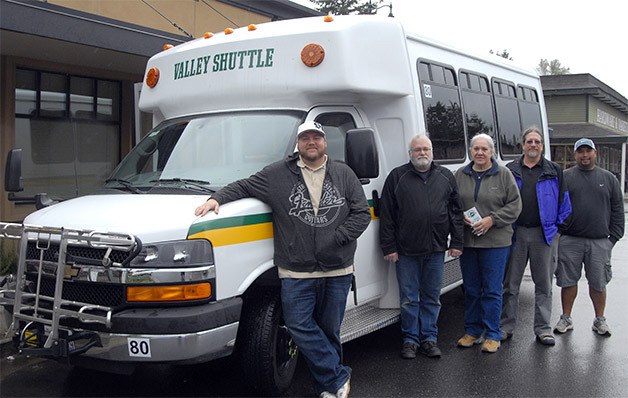Monday marks the start of the new, but also old, Valley Shuttle service in Snoqualmie Valley. Starting at 5:30 a.m. that day, three small buses, marked with the Metro Transit colors and the words “Valley Shuttle,” will enter service as the only public transportation option connecting Duvall, North Bend, and all points in between.
“We’re pretty excited,” says Amy Biggs, director of Snoqualmie Valley Transportation, which is administering the Valley Shuttle program. “It’s really unique, Metro’s never done it.”
Metro, after studying Snoqualmie Valley’s transportation needs and gathering public input from more than 500 local riders, is contracting with SVT for Valley Shuttle services for the next five years, as part of its Alternative Services program. The shuttle is one of two additions —the other is a new route 208 connecting North Bend, Snoqualmie Ridge and the Issaquah Transit Center, afternoons and Saturdays—in a package of sweeping changes that eliminate most Metro routes within the Valley and several to and from the area during the day.
The shuttle’s route, with stops in Duvall, Carnation, Fall City, North Bend and three in Snoqualmie, is also the “last connection” in the Valley, said Metro supervisor Matt Hansen in a presentation earlier this year, and thus safe from further Metro cuts.
“Metro will not eliminate last connections,” Hansen explained.
Biggs points out that the change is actually an increase in service to the Valley, and she’s excited about its potential for local residents, especially in combination with the 10-year-old Snoqualmie Valley Transportation program, serving roughly 36,000 people annually.
“It will give people the ability to walk to a place to take a bus that they know is coming.”
Although that sounds simple, using public transit in the Snoqualmie Valley has rarely been easy. For years, Metro buses, with their frequent stops, were the only option for most people. Snoqualmie Valley Transportation, a joint venture of the Mount Si Senior Center, the Snoqualmie Tribe and other agencies, was formed in 2003, to provide 50-cent rides anywhere in the Upper or Lower Valley, as far as Monroe, $1 if riders had to transfer in Fall City. The service required reservations, but picked up and delivered riders from and to wherever they chose.
Financial challenges eventually drove a price increase to $1 per ride, and forced the program to shrink its borders last year, cutting out Monroe, Duvall and Carnation in succession.
Biggs, a volunteer until becoming director July 1, worked with the schedulers to develop more efficient routes, but these required riders to make reservations three days in advance. Another efficiency booster was the “circulator bus” implemented late last fall to ferry riders to and from central hubs in North Bend, Snoqualmie and Fall City, no appointment needed. Its regular stops include the Mount Si Senior Center, North Bend Library, North Bend Safeway, Snoqualmie Casino, Snoqualmie Coin Laundry and Sno-Falls Credit Union in Snoqualmie.
Both the on-demand SVT and the Valley Shuttle services are being managed by Snoqualmie Valley Transportation, but the only thing the two services share is the umbrella organization. Metro alone is funding the Valley Shuttle, at an expected cost of about $400,000 annually. The three buses are the property of Metro, and although they won’t be used on SVT routes, Biggs sees the two services working together to mutual benefit.
“At the very least, what we’d love to be able to do,” Biggs said, is “have SVT support the Valley Shuttle, and vice versa.”
They’ll have five years to try it, and possibly longer. Hansen said this change is less a down-sizing and more of a “right-sizing.” Although initial costs will be higher this year, the new shuttle service is expected to save Metro about $40,000 annually, he explained.
SVT continues to charge $1 per ride, which Biggs points out is still cheap, considering gas prices. The Valley Shuttle service will ask riders for a suggested donation of $1, as well, but “if somebody gets on and they just can’t afford to pay, we’ll take ‘em anyway,” Biggs said. Riders who connect from the Valley Shuttle on to a Metro route will have to pay the regular fare.
On Friday at about 7 p.m., the Route 224 bus leaves the Valley for the last time. The new Valley Shuttle buses, one northbound and one southbound, start up on Monday, September 30. With a “rock-solid” timetable from Metro, Biggs said, the buses will cover the Valley every 90 minutes.
To learn more, or download a schedule, visit http://www.mtsi-seniorcenter.org/svt.html, or call (425) 888-7001.
Schedule of routes



